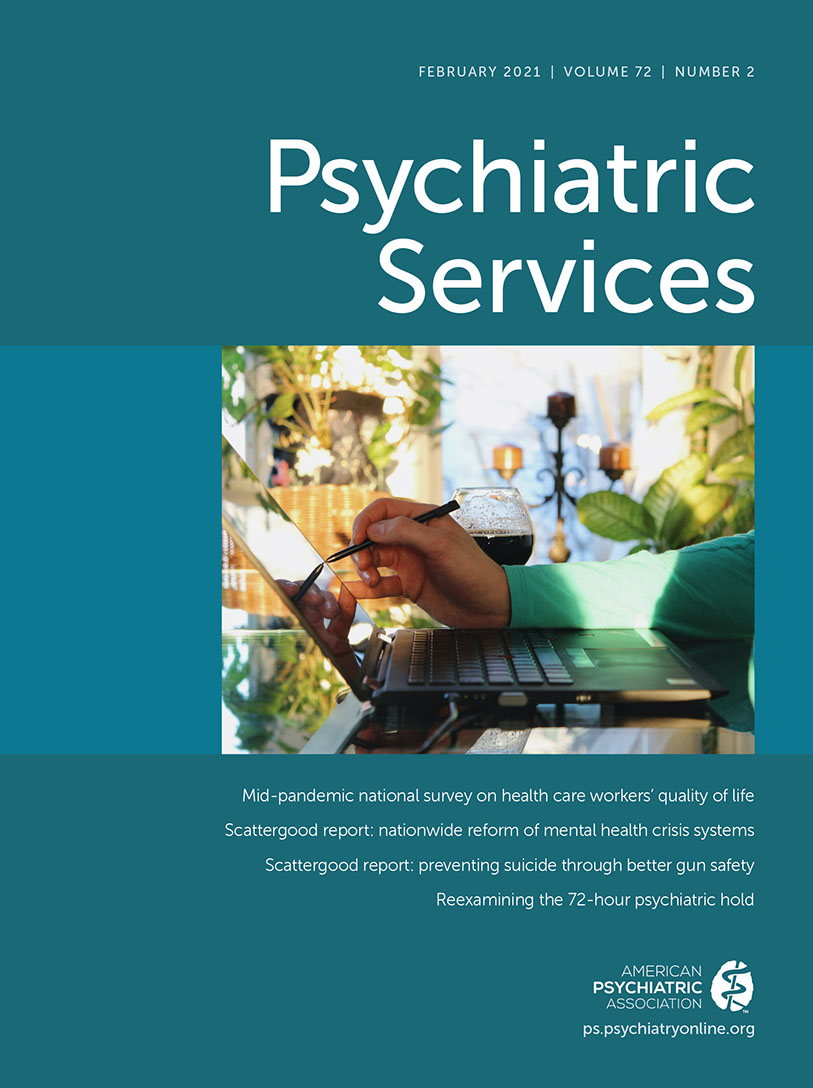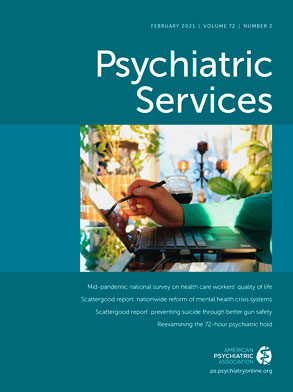Many adults with serious mental illnesses, such as schizophrenia and bipolar disorder, experience reduced decisional capacity associated with periodic exacerbation of their symptoms but also have periods of insight in which they can anticipate and competently plan for a future mental health crisis (
1). A psychiatric advance directive (PAD) is a legal tool that takes advantage of such times of self-awareness to formulate a plan for future crises. By preparing a legal statement—giving advance consent to a needed hospital admission and effective pharmacotherapy, for example—and appointing a trusted person to help effectuate such preferences during a future crisis, persons with serious mental illnesses can maintain control over their treatment and recovery, without the traumatic loss of control that often comes with involuntary mental health treatment (
2).
Research has shown that, with appropriate assistance, adults with serious mental illnesses can complete legally valid PADs and that these documents faithfully represent their preferences and help them obtain effective crisis treatment while avoiding coercive interventions (
1,
2). Unfortunately, a large gap remains between the abstract promise of PADs and their implementation; few patients complete PADs, and most mental health professionals are unaware of them (
3,
4). How should the problem of PAD implementation be understood differently to bridge the gap between theory and practice for a promising legal and clinical intervention?
Background
Despite their promise, PADs have yet to be widely implemented in health systems in the United States because of several persistent barriers, including the inherent difficulty of completing PADs without assistance, inadequate infrastructure for retrieval of PAD information, clinician burden and skepticism, and health systems’ reticence to implement them (
5,
6). In this issue of
Psychiatric Services, Lenagh-Glue and colleagues (
7) describe some analogous barriers to using PADs in New Zealand. Here, we consider a new way of conceptualizing the PAD implementation problem, using the extended metaphor of a communication device to focus on components of the PAD process that must be addressed for PADs to achieve their potential.
The PAD As Communication Device
To better understand the PAD implementation problem, we consider the PAD essentially as a remote communication device. It is a mechanism for conveying information among key actors to optimize the crisis treatment process and outcomes for an individual. Ideally, a PAD should facilitate treatment that is compatible with clinical expertise, feasible, and consistent with the wishes of a temporarily incapacitated patient. To be most effective, the PAD must incorporate the functions of both a “transmitter” and a “receiver.” The patient’s wishes must first be transmitted and stored for timely and efficient retrieval in the future, then intelligibly received by a proxy decision maker and clinician. In many cases, the information must be retransmitted by a health care proxy to a health care provider, who must in turn receive and understand the information and act upon it appropriately. Optimally, the PAD as a communication device can facilitate a process of shared decision making between the patient and the proxy and provider.
PADs have fostered communication in the controlled and relatively well-resourced clinical settings that researchers study, but PADs tend to break down—or get overlooked completely—under the real conditions of emergency care in the United States (
3). In practice, the “device” (the PAD) seldom works as designed. Several operational barriers must be addressed to enhance both the transmitter and receiver features of PADs (see table in
online supplement).
The Transmitter Problem
The “transmitter” functions of PADs include several important features, such as one’s basic ability to understand PADs as a legal concept and as a mechanism to convey one’s consent for treatment in the future. The person drafting the PAD must have recovered from an illness exacerbation and have enough awareness of the illness to be able to construct a plan for future care. The person must be able to convey the plan in a document that is often encumbered with legal language and requires witnessing and notarization. The treatment instructions must be relevant, informative, coherent, and succinct for the PAD to be helpful to a potentially unknown treatment team.
Trust is a critically important transmitter element of PADs; the person must be able to trust in the legal authority of advance care planning and have a trusted person who is able, willing, and available to serve as a legal proxy during a crisis. Many persons appointed as health care proxies have little awareness of their responsibilities and have not been prepared for their roles, which can lead to ineffective and inefficient advocacy. Ideally, proxies also need experience in how to navigate emergency settings and communicate with clinicians.
All of these transmitter features of PADs can loom as formidable barriers for people with serious mental illnesses, especially those with limited economic resources and social capital. Yet studies have shown that structured assistance with PAD completion with a trained PAD facilitator can overcome these transmitter barriers (
1,
8). Unfortunately, there is no widely available referral network for such assistance. To develop such a facilitation network, a demonstration project in North Carolina is training peer support specialists, members of the National Alliance for Mental Illness, health care professionals, and others to assist with PADs (
9). In addition to developing and installing a referral network, the project is working with health systems, crisis facilities, and other provider stakeholders on implementing system changes and delineating responsibilities in implementing PADs. In addition, a new mobile computer application developed by the Substance Abuse and Mental Health Services Administration and the American Psychiatric Association offers promise in assisting in PAD completion, although its use and outcomes have yet to be evaluated (
10).
The Receiver Problem
On the “receiver” side, PADs are often not consulted or activated during crises, even with the proliferation of electronic health records (EHRs), because there are relatively few PADs on file in most U.S. health care systems. Specialized websites for storage of advance care planning documents have been increasingly eclipsed by use of EHRs, where PADs can also be stored. Unfortunately, most EHRs scan advance care planning documents in their entirety, essentially leaving a stack of documents on file that cannot be easily retrieved or manipulated as accessible digital data.
Despite the growing attention to end-of-life advance care planning and effective national campaigns encouraging such conversations (
11), attention to PADs as a behavioral health–focused conversation lags. There are important differences between end-of-life advance directives and PADs in that end-of-life directives typically articulate wishes about end-of-life treatment that the patient is unlikely to later refuse and treatment is typically not imposed over patient objection. PADs, in contrast, are usually intended to bind a patient, when well, to future treatment and, on some occasions, might be used to overrule the patient’s contemporaneously expressed preferences during an incapacitating crisis. Health care systems are required to document and comply with legally authorized advance directives, including the recognition of the appointed health care proxy as the patient’s legal representative during an incapacitating crisis (
12). The Centers for Medicare and Medicaid Services has made PAD compliance a “condition for participation” to receive reimbursement from these federal payers and recently implemented new key quality measures focused on PAD implementation on psychiatric units (
13,
14). Thus far, lapses in compliance are typically complaint driven, and systematic enforcement is infrequent. Many advocates hoped that potential sanctions for noncompliance would be an effective lever for health system compliance. Unfortunately, clinicians and health systems have yet to build effective awareness and structural mechanisms to ensure that PADs are made available and are then reviewed and activated by clinicians and incorporated into treatment decisions for patients who experience crises.
The Neglected Right to Be Deemed Incapable
A PAD that exists solely as a stored document—never read, consulted, activated, or applied to the care and treatment of the person who wrote it—is no more useful than a message in a bottle. Legal activation of a PAD is almost entirely at the discretion of clinicians. As such, acute care mental health clinicians play a critical gatekeeping role in the implementation of PADs. The activation of a PAD puts into motion its temporary consent and decision-making authority but is conditioned on the recognition and documentation of diminished capacity. Clinicians often fail to assess decision-making capacity and typically do so only when a patient refuses recommended treatment; clinicians often too readily accept as valid the consent from patients with impaired decisional capacity (
15). Patients who prepare a PAD are asserting a right to maintain their control over treatment even when they are incapacitated. The clinician who fails to conduct a capacity assessment and activate a PAD when appropriate preempts the patient’s right to control treatment preferences by being deemed incapable, triggering PAD activation. Systematic training is needed for clinicians on capacity assessment and the elements of PADs, patients’ rights to use them, clinicians’ crucial role in implementing them, and their potential benefit.
Health systems need to take PADs seriously and initiate systemic changes to honor PADs as a form of advance care planning. This undertaking especially includes addressing potential cultural and linguistic barriers to completing PADs and making culturally informed capacity assessment central to informed consent processes. They also need to engage their clinical leaders, attorneys, and risk managers in supporting PADs and in guiding clinicians in respecting PADs. The default of involuntary commitment for patients who do not consent to treatment is grossly unfair to patients with PADs. If involuntary commitment is the default, there is also a risk of exacerbating racial disparities inherent in the overrepresentation of patients from racial-ethnic minority groups in involuntary care.
Conclusions
A serious investment by clinicians and health care systems to widely implement PADs could significantly improve the treatment process for psychiatric patients who experience incapacitating crises. Upon such commitment, PADs could improve continuity of care and long-term outcomes for persons with serious mental illnesses. Outcomes include avoiding involuntary hospitalization and even reduced risk of criminal justice involvement. Implementation of end-of-life directives was slow at first, with challenges that were analogous to those faced in implementing PADs in both their transmitter and receiver functions. Still, over a period of decades, the combination of increasing public awareness, clinician training, advocacy by patients’ rights constituencies, and regulatory leverage applied at the institutional level has led to routine use of these legal documents for critically or terminally ill patients. Dissemination of PADs lags far behind that of end-of-life advance directives, but applying these same tools of implementation could help PADs “catch up” and expand the benefits of advance directives to a deserving yet underserved population.

